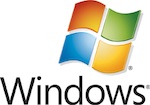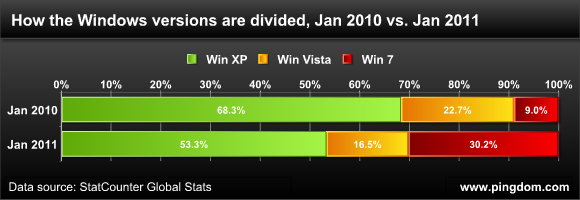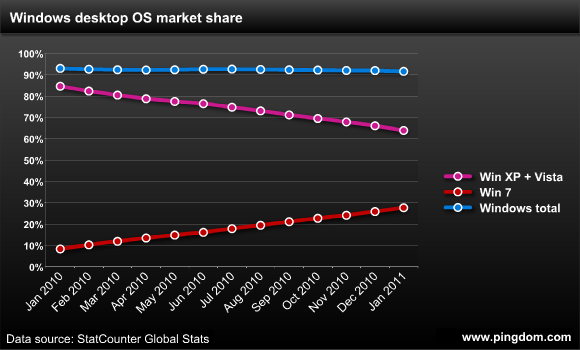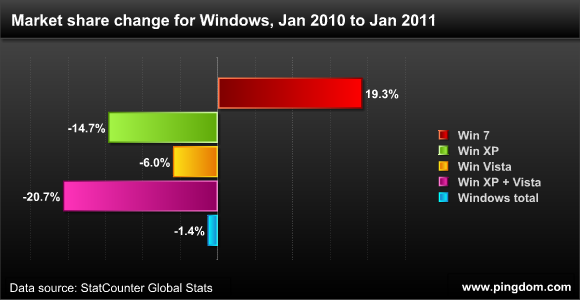 Pardon the wordplay on “dog-eat-dog world,” but as you’ll see it applies perfectly to what is going on with Windows in the desktop OS space.
Pardon the wordplay on “dog-eat-dog world,” but as you’ll see it applies perfectly to what is going on with Windows in the desktop OS space.
Because there are several interesting things going on. Some quite expected, others not so much.
First of all, the situation now is that Windows 7 has made a real splash. It’s already passed Windows Vista and is getting closer and closer to that clunky old workhorse that refuses to die, Windows XP.
This is how the different versions of Windows were divided one year ago, versus now:

As you can see, Windows 7 has gone from being on 9% of the Windows machines out there to over 30%, while both Vista and XP have gone the other way.
This is a natural development for two reasons:
- People are upgrading to Windows 7.
- Most new PCs are sold with Windows 7 preinstalled.
That’s not exactly rocket science, but you may start to see where we are going with that dog-eat-dog analogy.
The thing is that Microsoft has called Windows 7 the fastest-selling OS in history. They have published some amazing stats. For example, Microsoft reported in October 2010 that they had sold more than 270 million Windows 7 licenses (it was launched in October 2009).
Amazing, but…
The dog-eat-dog part
This graph should give you a pretty good idea of what’s going on.

There are a couple things we’d like to point out here:
- Look how Windows as a group (i.e. Windows 7 + Vista + XP) hasn’t gained any market share at all in the desktop OS space. That’s the blue line at the top.
- Then look how Windows 7 and the combined Windows XP + Vista lines mirror each other. One is increasing at the same pace the other is decreasing.
And that’s the really interesting part. Windows 7 may be a huge success and selling like crazy, but it isn’t growing the overall market share of Windows as you might have expected. It’s cannibalizing the other versions of Windows.
In part this is what Microsoft wants, they want people to use the latest version of Windows, they want existing Windows users to trade up, they get to sell product, but you can bet that they also want the overall Windows market share to grow. And that part is failing.
Granted, more and more people have computers, so even if the market share stays the same, the volume increases, but it’s not exactly promising for the Windows platform.
Windows is actually losing ground
There’s one interesting little detail left that you can’t really see in the graphs above. It’s not just a dog-eat-dog world, other animals are coming in to have a bite as well.
Let’s take an even closer look at how the desktop OS market share of Windows has changed over the last year.

Again, it’s clear that the increase of Windows 7 closely matches the combined decline of Windows XP and Vista.
But note also the overall decline of 1.4% of Windows as a group. So, in spite of the success of Windows 7, Windows’ overall share of the desktop OS market is decreasing, albeit slowly. (Perhaps we should say “still decreasing,” because it’s been doing so for years.)
So, where did that missing 1.4% go?
Let’s just say the people at Apple are probably quite pleased with themselves. Last year, Mac OS X increased its desktop OS market share by… 1.4%.
Quite a coincidence, isn’t it?
Mac OS X now has 6.6% of the desktop OS market, which is still tiny compared to the massive 91.6% that Windows has, but these numbers strongly indicate that while Microsoft has gone cannibal, Apple is gaining new users from the Windows crowd.
Data source: StatCounter Global Stats, based on visitor stats from 3+ million websites.


























